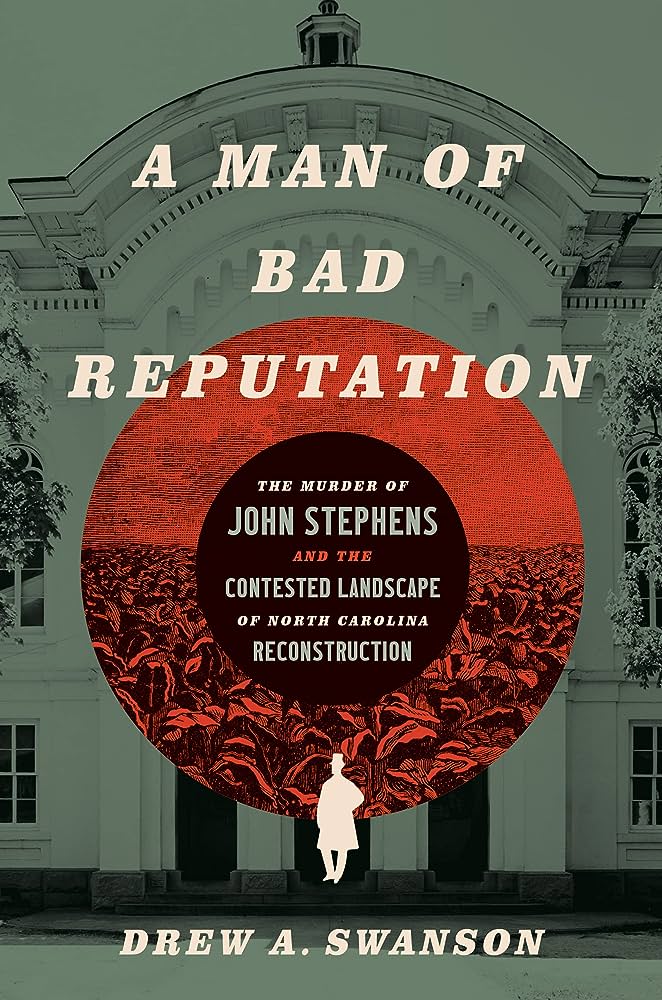

Drew Swanson is Jack N. and Addie D. Averitt Distinguished Professor of Southern History at Georgia Southern University. This interview is based on his new book, A Man of Bad Reputation: The Murder of John Stephens and the Contested Landscape of North Carolina Reconstruction (University of North Carolina Press, 2023).
JF: What led you to write A Man of Bad Reputation?
DS: I was intrigued by a long-standing murder mystery. North Carolina state senator John Stephens was assassinated in a basement room of the Caswell County Courthouse in 1870, and the state spent decades wondering who committed the crime. The intrigue only ended when the last surviving conspirator, once head of the county’s Ku Klux Klan, passed away in 1935 and his sealed confession was made public. It was a story I had come across when writing a previous book, and despite the fact that it is a common part of state lore, I felt it needed a fuller telling, especially because I was convinced that it was a turning point in southern Reconstruction. The fact that the story came with a plot, complete with twists, turns, and a surprise ending, made it all the more enticing.
JF: In 2 sentences, what is the argument of A Man of Bad Reputation?
DS: John Stephens’s murder—a local event rooted in tobacco agriculture and the rhythms of rural life—was a critical moment in North Carolina’s Reconstruction, and rippled outward to influence the federal effort to reshape the South. Memory of the event proved equally contentious in the decades that followed, as North Carolinians labored to mold public memory and redefine the meaning of Reconstruction.
JF: Why do we need to read A Man of Bad Reputation?
DS: We still live in the aftermath of Reconstruction, as distant as those years may seem. Southern politics, race relations, and tensions between rural and urban citizens were fundamentally reshaped by the events of the 1860s and 1870s. Stephens’s murder and its public portrayals that followed highlight the process of transforming a dramatic event into public memory.
Parts of the story also feel surprisingly contemporary. There are contested elections, accusations of political bribery, efforts at impeachment, rumors of “false-flag” operations, and contentious press battles over what happened and what it meant. It’s a reminder that our divisive moment is, in fact, nothing new.
JF: Why and when did you become an American historian?
DS: I actually started my professional life as a wildlife biologist, but I couldn’t shake a lifelong love of history that had been reinforced by some excellent undergraduate history professors. As much as I enjoyed my work in the field—I was a park ranger in Appalachia—I found myself thinking about human history as often as natural history. I began graduate school in history at night to scratch that itch, and eventually found my way to the PhD program at the University of Georgia and to environmental history as a field. It allowed me to combine my interests in history and nature (and I could pretend that I had a plan all along!).
JF: What is your next project?
DS: I’m returning to my environmental history roots, with a study of the consumer culture of American hunting since the Civil War. It’s a book focused on an irony: American hunters imagine that they go the woods “to get away from it all,” but they sure do take along a lot of stuff, from composite compound bows, to motion-activated trail cameras, to expensive atvs. How did this consumer culture come to be, and how did hunters grow comfortable with it?
It’s turning out to be a fascinating story that’s leading me to all sorts of strange places: from early hunting magazine ads to Ted Nugent to the origins of Cabela’s Outfitters.
JF: Thanks, Drew!